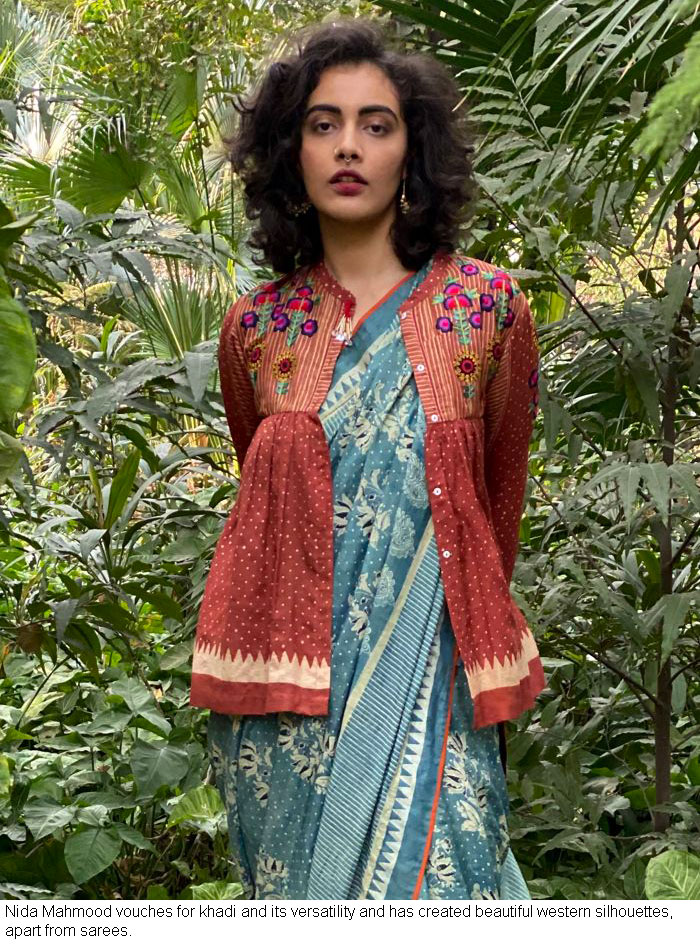
Category: FABRICS
Country: India
The fabric is now easier to maintain with designers turning it into high-fashion garments
Updated At: Oct 23, 2022 09:53 AM (IST)
Gurnaaz Kaur
Celebrity fashion designer Rohit Verma has been working on khadi for almost 25 years and says anything and everything can be designed in this textured hand-woven fabric. “It can be made into resortwear. I’ve designed gowns out of it, given it western cuts, enhanced it with embroidery. I’ve even done an Anarkali with about 50 metres of the fabric. I’ve always tried to give a new twist to khadi because it has potential.”

Nida Mahmood vouches for khadi and its versatility. “It is one of the best sustainable fabrics available to us. Natural and hand-woven, we are making amazing use of it today — not just as traditional sarees, but even high-fashion garments. Different kinds of Indian printing and embroidery techniques are being extensively used on it. The yesteryear’s dull and boring khadi has had an amazing facelift.”
Nida has extensively used the fabric in her designs over the last five years. She has created beautiful western silhouettes apart from sarees and has experimented with natural dying on the homespun yarn. “We have, in fact, created a sustainable brand that does only natural fabrics like khadi,” she says.
Superstar Kamal Haasan’s fashion label KH House of Khaddar is on a mission to save the art of khadi and make it cool and relatable to the young urban consumer.
Admiring the sustainability factor of the fabric, designer Amritha Ram asks fashionistas to look at it from the brand’s prism. “Khadi is generally stereotyped as being too Indian and without any cuts. But it has all the makings that other fabrics have — you can weave it the way you want, from the simplest of co-ords, travel wear to even khadi denim, the possibilities are endless.”
Nida Mahmood vouches for khadi and its versatility and has created beautiful western silhouettes, apart from sarees.
Working closely with the Khadi and Village Industries Commission (KVIC), Ashwini Pable runs two design labels — Pable, that creates luxury prêt, and Rentiyo, a mainstream lifestyle brand — which are exclusively promoting khadi. From studying khadi extensively since 2017 to getting a khadi mark licence certification, Ashwini wants to break some myths about the material. “Khadi is mainly a process and any fabric that is handspun on charkha and woven on loom qualifies as khadi. It could be cotton, silk or wool. The most interesting thing is that it has a zero-carbon footprint process and does not use electricity in manufacturing. It saves 92 per cent water consumption compared to the mill-made fabric, making it most eco-friendly.” She also points out that while many brands claim to be making khadi, those who do not have the certification are not making real stuff.
Contrary to popular belief that it is high-maintenance, designers say it is very easy to handle. Depending on its thread count, you can choose to wash it at home or opt for dry cleaning. “Any fabric over 100 thread-count is called muslin and the fine muslins are the most gorgeous form of khadi in terms of feel and comfort and deserve to be treated with love,” says Ashwini.
She further explains, “The lower thread-count fabrics below 100 can all be machine-washed at lower RPMs. Muslins and slub silks can be gently hand-washed. It’s only the pure silks like tussar, mulberry, gheecha, katiya and matka that have to be dry-cleaned.”
Mahmood and Verma say most khadi fabrics can be handwashed. “However, if embroidered or printed, one needs to follow wash-care instructions and needs to maintain the fabric with gentle handwash and regular light starching if they like crisp clothing. Hang the khadi garments on hangers to dry after wash to avoid de-shaping of the general fall of the garment. This is true only for fine-count khadi. Thicker-count khadi is a strong fabric but needs regular care. Any fabric with sheen can’t take heavy-duty washing or strong detergents and khadi silk and mercerised khadi need to be washed with gentle detergents,” adds Mahmood.
Promoting New Model Charkha (NMC), which uses polyester and natural yarn, Gautam Gupta of label Asha Gupta terms khadi a sign of purity and hard work. “This fabric is skin-friendly, breathable and environment-friendly. At times, khadi shrinks after being washed as it does not go through chemical processes to maintain the properties of shape. But a lot of brands give the yarns a chemical treatment during pre-loom, on-loom, and the off-loom process to make it lustrous, tensile, low-shrinkage and low-maintenance.”
The fashion industry is looking for sustainable options more than ever before and this age-old symbol of self-reliance and freedom is a favourite among designers.
Courtesy: https://www.tribuneindia.com/news/features/rooted-in-ethos-khadi-goes-haute-444013
Copyrights © 2025 GLOBAL TEXTILE SOURCE. All rights reserved.